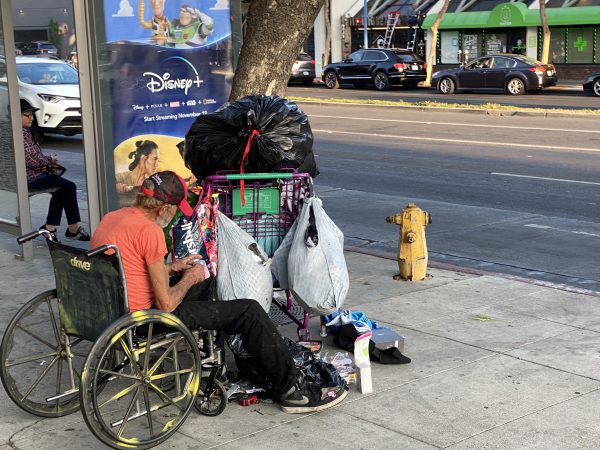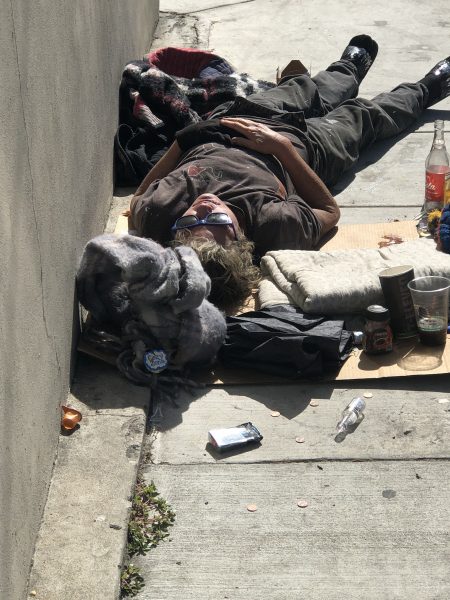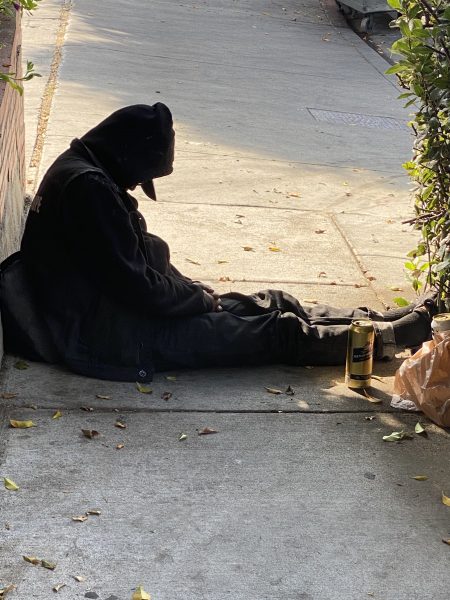
Who are the homeless in West Hollywood? And why don’t they have a home? A series of interviews of homeless residents by the city’s Human Services and Rent Stabilization Department paints a picture of an ethnically diverse community, the majority of whose members are gay and bisexual, and more than a third of whom say don’t have enough money to afford a home.
The survey was conducted in April and May of this year using questions from a survey prepared by the Los Angeles Homeless Services Authority. The City of West Hollywood began conducting that annual local survey in 2017. It was overseen by consultant Abby Arnold, with its data analyzed by Murtaugh & Associates, a consulting firm.
Surveyors spent 30 to 45 minutes soliciting information from each of 68 homeless people in West Hollywood, a number that represents more than half of the 131 people identified as homeless in West Hollywood in the January 2019 countywide homeless count. That annual survey includes all areas of Los Angeles County except for Glendale, Long Beach, and Pasadena, which don’t participate in the countywide survey.
Why Are They Homeless?
A report to the City Council from the city’s Human Services and Rent Stabilization Department says that “unemployment or financial reasons remained the top reason for homelessness (35.29%), with problematic substance use in second place (26.47%).”

“More than half of West Hollywood respondents consistently report that they are chronically homeless,” states the report. At 51.47%, that is about twice the 26% rate of those in the 2019 countywide survey. “In 2018, 61.67% of respondents in West Hollywood were chronically homeless, and in 2017, the percentage was 54.5%.”
The survey suggests that the cost of housing may be a major factor in homelessness, given that only 39.7% of those interviewed said they actually were unemployed. That’s almost half the unemployment rate among those participating in the 2018 survey, which was 68.3%, and the 2017 study (64.9%).
One reason some people may be living on the streets is the conflicts or violence they have experienced where they once lived. The 2019 survey reports that 29.4% of the homeless participants cited conflicts with family or household members, domestic violence, parental abuse, partner abuse, dating violence, stalking, or being kicked out of home due to sexual orientation or gender identity.
Certain health or addiction issues may be another factor. The survey reports that three out of four people experiencing homelessness in West Hollywood had at least one health condition in 2019, similar to the number in 2018. There were significantly increased reports of post-traumatic stress disorder, with 32.35% respondents reporting PTSD in 2019 versus 20% in 2018. There was also an increase in alcohol abuse, with 32.35% reporting problematic alcohol use in 2019, compared with 18.33% in 2018.
There was a decrease in the percentage of people reporting serious mental illness (36.76% in 2019, 46.66% in 2018). However, the report notes that West Hollywood respondents were “more likely to self-report serious mental illness than those in the overall (county survey),” 2where 29.50% reported mental issues.
Who Are the Homeless?
The survey shows that the homeless in West Hollywood are, on average, younger than the homeless population identified in the 2019 countywide survey. Of those surveyed in West Hollywood, 11.8% were aged 18 to 24, compared to 6% of those in the countywide survey.
Eighty percent of West Hollywood’s population is white. However, only 35.3% of those homeless people surveyed identified themselves as Caucasian (compared to 24.5% in the county survey). Those who identified as Latin constituted 30.9% of the homeless survey in West Hollywood, versus 36.6% of the homeless in the county as a whole. Those identifying as African-American made up 27.9% of the West Hollywood homeless survey, compared to 33.2% in the countywide survey. A little more than 10% of those surveyed identified themselves as being of American Indian or Native Alaskan descent. The countywide survey showed only 1.7% who identified that way.

The homeless surveyed in West Hollywood this year were more likely to have experienced at least one form of violence or abuse. “In 2019, 58.82% of West Hollywood respondents had experienced at least one form of violence or abuse compared with 48.3% in 2018 and 38.6% in 2017,” the report states. By contrast, 35.55% of this year’s respondents in the countywide survey had a history of violence or abuse. However, the survey reports that only 5.9% of the homeless respondents in West Hollywood are currently fleeing violence, compared with 9.2% in the countywide survey.
“Among those in West Hollywood reporting violence or abuse, 75% were male, 22.5% were female, and 2.5% were gender non-conforming; 15% identify as transgender, compared with 2.25% in the (countywide survey), and 35% identify as straight, 27.5% as gay or lesbian, and 30% as bisexual,” the report says.
Nearly a third of those survey in West Hollywood said they had engaged in sex for money. In answer to the question: “Have you ever worked or done an illegal act and someone took some or all of the money?” 29.4% of West Hollywood respondents said “yes,” compared to 20% in 2018. In the countywide survey, only 15.7% said they had engaged in such activity. One of the West Hollywood respondents (1.5%) identified sex work as the way in which they had been exploited or trafficked by someone else, compared to 5% in 2018.
HIV/AIDS As an Issue
HIV/AIDs is a major issue among the homeless in West Hollywood, according to the survey. “In the 2019 West Hollywood survey, 27.94% of respondents disclosed that they are living with HIV/AIDS, compared to 1.6% in (the) countywide survey,” says the report on the survey. “This represents an increase from 8.33% in West Hollywood in 2018 and 18.2% in West Hollywood in 2017.
“Of the 18 HIV-positive people experiencing homelessness in West Hollywood, 12 were gay men and three were bisexual men. Five of the respondents were transgender. Almost all (16 of the 18) were chronically homeless, and the majority (10) had been in Los Angeles County for more than 20 years.
“Eleven of the 18 reported a history of violence or abuse. Their average age was 37.7 years. The racial distribution was close to even, with five white, five Latinx/Chicano, four African-American, and four American Indian/Alaskan Native.
“The sexual orientation, racial distribution and average age of the respondents living with HIV more closely reflect the Los Angeles County HIV epidemic than the City of West Hollywood’s overall HIV-positive community,” the report states. “As in the county, gay and bisexual Latino and African-American men carry a disproportionate burden of the epidemic. The fluctuation in the numbers of homeless community members living with HIV relates to the transitory nature of the population as a whole. Though the number of respondents living with HIV is concerning, the city, through its social services contracts, has the capacity to bring each of these community members into care and support them in maintaining adherence with treatment.”
In 2019, 55.9% of West Hollywood respondents reported that they have spent time in jail, foster care, inpatient mental health treatment, or probation, compared with 73% in 2018. West Hollywood respondents are less likely to have been involved with the legal systems and systems of care than those in the countywide survey.
Of those surveyed in West Hollywood, 61.8% reported receiving some kind of government assistance, similar to 63% in 2018. This included 35.3% who receive food assistance, 30.95% who receive general relief, 19.1% who receive government supplemental security income or Social Security disability insurance income, and 11.8% who receive Medi-Cal or other health support. “General relief” is a county-funded program that provides financial assistance to poor adults who are ineligible for federal or state programs.

As a homeless youth living here in subsidized housing, I don’t know about this.
The good and generous people of Weho do not deserve to be harrassed or attacked by the homeless. Patience is wearing thin.
Governments from Washington down to the smallest city are abject failures when it comes to actually getting people off the streets. LA City, for instance, could take ten acres of Griffith Park to set up a “refugee” camp to at least attend to the needs of families and children now living at curbside. Sums of money have been vested to build places for the homeless to live using out-dated ideas of what a living space actually is. Further, most of the funds directed for that purpose will be spent on administering the program. I see nothing but a bleak fuuture… Read more »
Weho could end most homelessness by buying up the meth hotels in the city open the auditorium as a shelter from 11 pm to 7am . And The weho city housing Dept needs to get 200 emergency county and city sec 8 vouchers. Most weho homeless want housing. Court order rehab for the drug addicts and alcoholics saves lives. Rehab not jail even if it takes 150 x. The new mayor is not progressive doing the same as Duran. Weho We Can end most homelessness in Weho.
Exactly
The survey has not taken into consideration all the people who sleep in their cars or live 4+ people to a one room apt who are employed but just can’t find affordable housing. There are a lot of people who go to WeHo for entertainment but leave at certain times because of the permit laws. These people have to park their cars in homophobic areas where they don’t feel safe. The greater problem is a lack of affordable housing, and for people who are sleeping on sidewalks who are likely severely suffering from mental issues, there needs to be more… Read more »
I live in West Hollywood In the homeless I see or most are mentally ill patients And alcohol and drug abuse I think that’s why they’re homeless and most of them actually prefer to be homeless then to have a home Because they have problems with authority An in subsidized housing units that is offered to them The biggest rules are no drugs no alcohol And they don’t like to be told what to do But then who does And I’m just getting tired of the fecal matter all over the streets and seeing needles crack pipes meth pipes prostitution… Read more »
I think that without a solution or plan these statistics are vacuous and elitist. The truth is West Hollywood is completely out of touch with the homeless and would prefer to allow McMansions and outrageously priced condos to take precedence. There is such a thing as a middle ground. The truth is the beougi population can’t be bothered. Oh yes, unless it happens to them.
Your so damn right!
In the 90s I worked at Wild Oats in WEHO. St. Vickys up the street would give a huge gaggle of vagrants coupons for subway sandwiches. These hordes of vagrants would descend on our shopping center and get their sandwiches and then hang out smoke cigarettess and annoy passerby. Including stealung from our store. They seemed in good enough health to seek out services. Their importuning of the neighborhood gave rise to alot of animosity to the homeless in general and this was a very charitable contingent. I lived up the street on Westbourne so I actually lived it.
What a complete waste of time and money. No wonder the country’s homeless are all shipped out on one way tickets to Los Angeles county. Where else in this country can you defecate on the sidewalk with no repercussions, and get interviewed and welcomed while you do it?!?!
That’s funny!
What a bunch of malarkey! Have them go out at night and do interviews. Most of the people I see could not give a coherent answer. What a waste of money.
Do all these numbers and analytics do anything to alleviate this tragic condition that only gets worse? What is the purpose of this? Will knowing these stats over and over again instigate any new ideas or make it easier to make touch decisions? Is there anything new here?……Too many questions.
Exactly